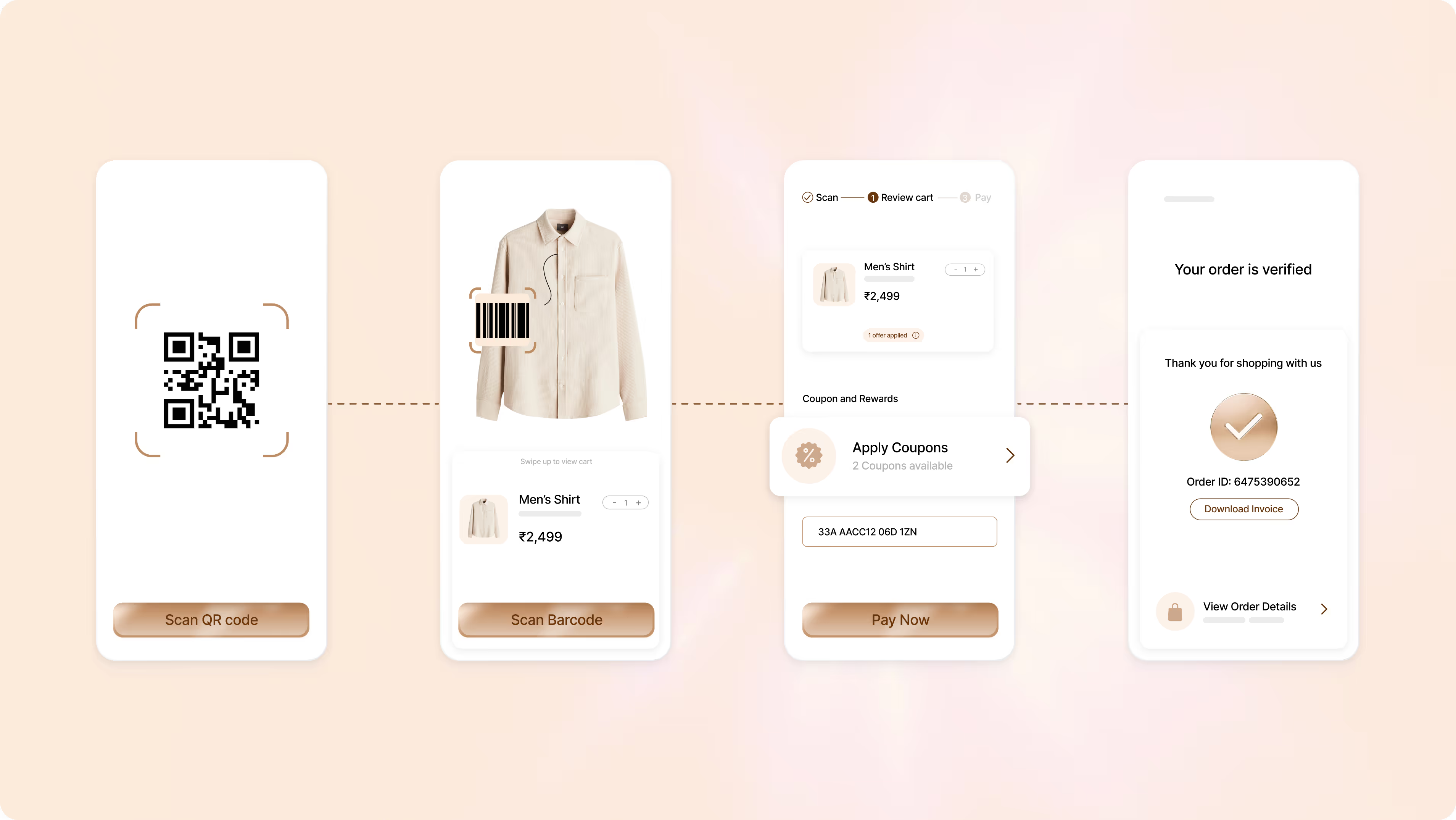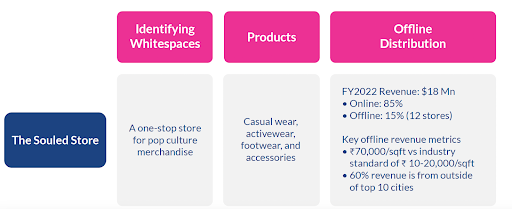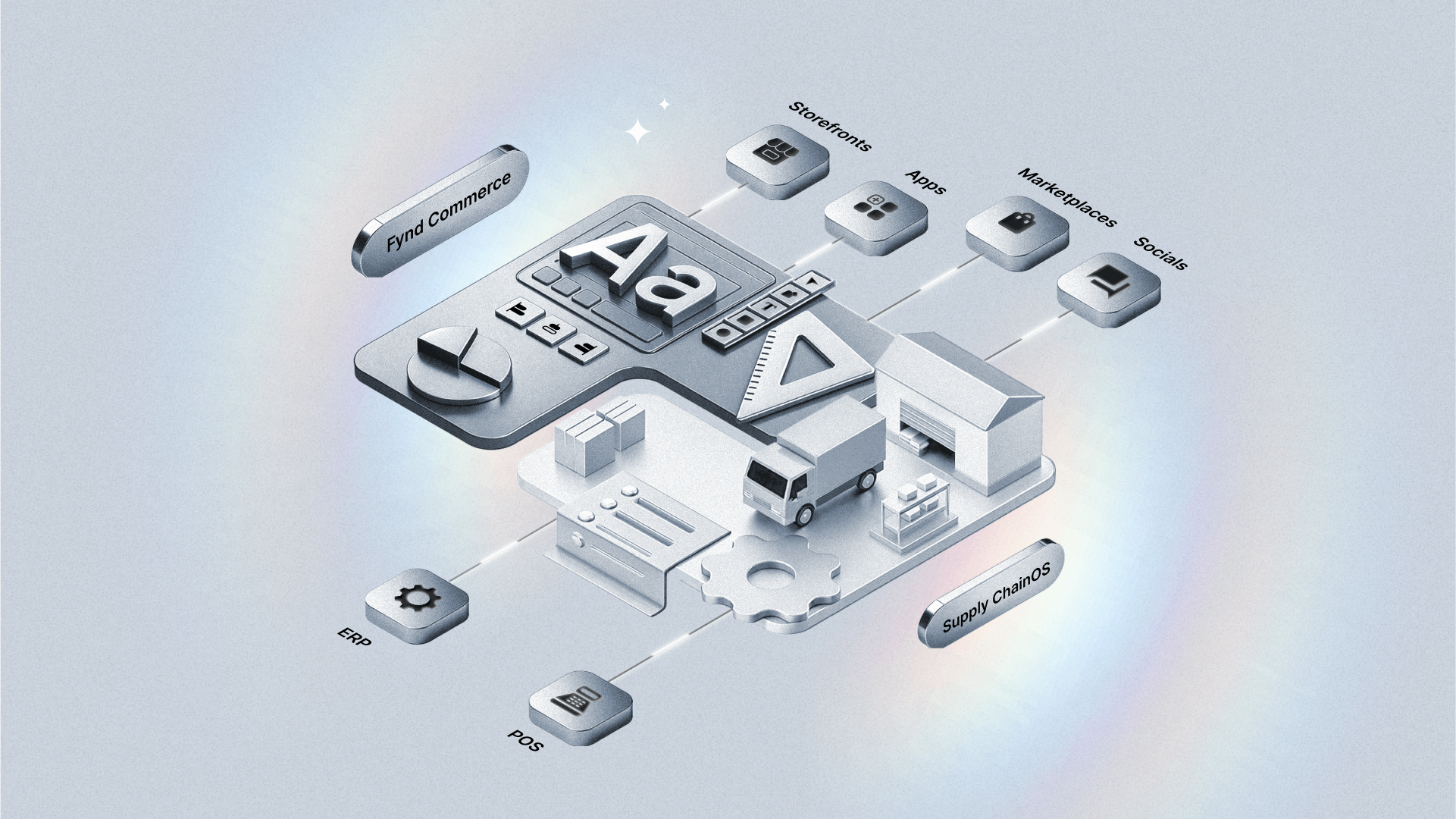Click to Bricks: D2C Brands Embracing Offline Expansion

Direct-to-consumer brands, often abbreviated as D2C, have gained prominence in recent years by selling products directly to customers through their websites and mobile apps without relying on intermediaries. By leveraging the power of e-commerce platforms, these brands have establish a direct connection with their consumers, bypassing traditional distribution channels and retailers.
However, many of these D2C brands across FMCG, retail, cosmetics, grooming, personal & hygiene care are now fast entering the physical store space. They're realizing that to truly build a loyal customer base, they need an omnichannel presence and incorporate offline channels into their business strategies. The Changing Retail LandscapeFor brands that started as e-commerce pure-plays, opening physical stores may seem counterintuitive.
However, an offline retail strategy comes with many benefits when executed well. Stores serve as a marketing tool to raise brand awareness, increase sales, and as a customer service channel for returns or exchanges. They give brands an opportunity to interact with and give personal experiences to customers by capturing data about local customers' shopping habits, preferences, and sizing information, both online and in-store.
There are several examples of such brands such as DaMensch, Libas, Jaipur Kurti, Snitch, Berrylush, SuperBottoms, Suxus, Faso, Zymrat, Bombay Shirt Company, Suta, Clovia, Zivame, Fable Street, Fab Alley, Miniklub, and CloudTailor that are expanding their offline presence across India. Here are offline expansion success stories of three most popular D2C, online-first brands, also featured in India Physical Index 2023.
Examples of Successful Offline- to-Online Brands
Souled Store's Offline Expansion Success Story

Source: India Phygital Index 2023
The Souled Store, an Indian D2C brand known for its trendy pop culture merchandise, was started in 2013 by three founders, Harsh Lal, Vedang Patel, Aditya Sharma, and Rohin Samtaney.
The brand identified the demand for good-quality t-shirts and other merchandise for one’s favorite IPL team, Star Wars, Batman, Superman, or WWE, at a reasonable price. Since offline seemed to be more challenging, expensive, and geographically restricted, the founders decided on an online launch for The Souled Store for faster growth and expansion.
Soon they established their hold in the market as a popular official, licensed merchandiser for cartoons (Scooby-Doo, Cartoon Network, etc.), TV shows (F.R.I.E.N.D.S, The Big Bang Theory), big-budget movies (Marvel, Harry Potter, Batman, Superman, etc.), and IPL teams.After six years of online success, The Souled Store opened their first brick-and-mortar retail outlet in a popular shopping destination like Bandra, Mumbai, and embarked on its offline journey.
The brand already had established a steady customer base through online avenues, but the presence of offline store was an opportunity to build trust and comfort to its customers. With its offline strategy, the brand wanted to acquire new customers, create more physical touchpoints for customer engagement, and more branding opportunities for themselves.
.png)
The impact of The Souled Store's offline expansion was substantial. The average offline order value is more than one and a half times that of online. The human experience and conversion upon entering a brick-and-mortar store is difficult to replicate online. The Souled Store has over 70% conversion at their offline stores.
The offline expansion strategy proved to be a game-changer for The Souled Store, resulting in heightened brand visibility, increased customer loyalty, and a strengthened position in the pop culture merchandise market.
The Sweet Success of Sugar Cosmetics' Offline Expansion
.png)
Source: India Phygital Index 2023
SUGAR Cosmetics is a leading Indian cosmetic brand, founded in 2012 by Vineeta Singh and Kaushik Mukherjee. The D2C brand took the Indian market by storm with a digital-first start. It built a strong online presence through e-commerce site, built its app for wider penetration, and invested heavily in social media & influencer marketing.
It catered to the niche market with cosmetics specifically suited for the Indian skin tone, and grew at a rapid rate, creating a buzz amongst the millennials for its products. The D2C online beauty brand stepped into brick-and-mortar retail in 2017 and dived aggressively into offline expansion strategy.
SUGAR Cosmetics constantly strengthened its retail network across the country and has over 45,000 retail outlets and plans to reach 1,00,000 outlets by FY 24, in the form of exclusive brand outlets, and kiosks in multi brand outlets. In line with their omnichannel strategy, offline expansion was a step-by-step approach. It started with D2C, then being available on partner portals or e-commerce sites other than their own, and then exclusive brand outlets and kiosks for a wider brand visibility.
SUGAR Cosmetics dominantly catering to young millennials and Gen Z, knew that the target audience is not limited to one channel, and to grow, SUGAR Cosmetics could not restrict itself to just a D2C online brand. The ambitious brand also knew that to be among the top five in the beauty category, they had to venture into offline retail and be where the competitors are.
As a part of its offline strategy, the brand aims to open its stores in the smallest cities in the tier-2 and tier-3 cities and acquire new consumers, especially in regions of absence of modern trade stores and lesser e-commerce penetration.
.png)
The impact of Sugar Cosmetics' offline expansion was significant. Today the brand clocks 65% of its total revenues through offline channels and 60% of the overall business comes from markets outside of tier 1.
Through its omnichannel approach, SUGAR Cosmetics witnessed a surge in brand awareness, as customers discover and engage with the brand through the physical stores. The immersive in-store experiences led to increased customer satisfaction and loyalty, as customers could confidently select products that suited their preferences and skin tones. The brands strongly believes that by offering a uniform offline and online experience seamlessly will it will dominate the market and fuel its growth to the top 5 beauty brands in the country.
Making Noise with Omnichannel Strategy
.png)
Source: India Phygital Index 2023
Founded by the Khatri brothers, Amit and Gaurav, Noise started with smartphone covers and accessories. In 2018, the brand underwent a pivotal transformation, shifting its focus to smartwatches and wireless earbuds. This shift in strategy proved fruitful, as Noise quickly emerged as one of the major players in the Indian smartwatch market.
Noise operated exclusively as an online-only brand until December 2020, when Noise joined forces with Vijay Sales, a prominent electronics retail store chain in India. This partnership enabled Noise to tap into Vijay Sales' vast network of 103 outlets, expanding its reach beyond the digital realm. With this association, Noise could offer its complete range of products both online and offline, reinforcing its dominant position in the Indian market.
Noise's expansion strategy prioritizes an omni-channel approach, with 80% of its focus on online channels and 20% dedicated to offline expansion. By maintaining this balance, the brand ensures it can effectively reach consumers across India, particularly in tier-2 and tier-3 cities where the demand for its products is particularly high. This offline expansion is driven by the brand's desire to provide customers with opportunities to see and experience Noise's offerings firsthand.
To support its expansion efforts, Noise has also bolstered its organizational growth measures and plans to scale up its employee strength. The brand is focused on cultivating strategic alliances and partnerships that will facilitate broader audience outreach.
Why D2C Brands are Opening Physical Stores
1. Tapping into the traditional consumer base
D2C brands have traditionally only sold products on their own websites and through social media. By expanding offline, D2C brands can reach out to a new consumer base that still prefers the traditional shopping experience of touch and feel before buying, and is hesitant to make purchases solely online.
2. Establishing trust and credibility
Offline presence allows D2C brands to establish trust and credibility among consumers who may be skeptical of online shopping. The physical presence of a store reassures customers about the authenticity and quality of the products. When customers can visit a physical space, it reinforces that the company is legitimate and invested in the customer experience.
3. Enhancing the customer experience
Offline stores offer customers an immersive and personalized shopping experience, especially important for apparel, beauty, and home goods companies. Customers can touch, feel, and try products before making a purchase, leading to increased customer satisfaction, increased conversion rates, and reduced product returns.
4. Greater brand visibility and discovery
Physical retail also provides an opportunity for greater brand visibility and discovery, which could be overshadowed amidst numerous brands competing in an online marketplace. With an attractive, experiential store design, D2C brands can create buzz and word-of-mouth marketing. Passersby may drop in, share photos on social media and spread awareness of the brand to new audiences.
5. Additional sales channel and revenue stream
Stores provide an additional sales channel and revenue stream. While e-commerce will likely remain the primary source of sales for D2C brands, physical retail presents an opportunity to reach new customers and drive impulse purchases. Many brands have found that online and offline sales reinforce each other.
6. Brand loyalty
For established D2C brands with a loyal following, physical stores become a destination where customers can interact with the brand on a deeper level. Stores host events, provide personalized styling services and generally become a hub of community. This cultivates a sense of brand loyalty that transcends any single channel.
7. Brand growth
To establish and grow a brand, it is essential for consumers to physically encounter and engage with the brand. While e-commerce may generate sales, expansion into offline space is a natural course to build a brand and grow sustainably.
8. Customer data and insights:
Offline expansion gives D2C brands an extensive knowledge of customer local preferences and buying patterns. These data and insights enable them to tailor their offerings and marketing strategies effectively.
Challenges of Transitioning From Online to Offline
As D2C brands expand into physical retail, several challenges also arise in transitioning business models. Opening physical stores requires significant upfront investment and ongoing costs like rent, inventory, and staffing. For brands accustomed to low overheads and operating primarily online, these additional costs can strain resources. Careful analysis of potential return on investment is critical before expanding offline. Brands also risk diluting their brand if the in-store experience does not match digital messaging. D2C brands must go in with their eyes open to the challenges that lie ahead.
Challenges to Consider
1. Cost
Physical retail space is expensive, especially for brands accustomed to low-overhead online-only models. The cost of leasing and operating stores must be balanced with the benefits.
2. Logistics
Managing offline retail locations adds complexity to D2C brands’ logistics, operations, and supply chain management. D2C brands and retailers need to establish robust systems to forecast demand, handle inventory management, handle returns and exchanges, warehousing, oversee staff in physical locations as well as online, and timely delivery of products to stores. This requires adapting existing systems and processes or building new ones to support omnichannel retail.
3. Ensuring consistency across channels
The customer experience differs between online and offline shopping and striking a balance can be challenging for D2C brands. A seamless experience across channels includes consistent branding, visual identity, product offerings, integrating point-of-sale systems on e-commerce platforms, synchronization of inventory, pricing, promotions, service, and policies across online and physical stores. Failing to do so risks confusing or alienating customers. Retailers must also align their offline operations with the brand image and values of the D2C partner and invest in technology to ensure a cohesive experience for customers.
4. Competition
Offline retail introduces new competitors as D2C brands contend with established brick-and-mortar retailers. They must differentiate themselves to attract customers, which may require adapting product lines, services, or marketing for offline channels.
5. Training and up-skilling employees:
With the entry of D2C brands, retailers must train their employees to adapt to new technologies, customer service standards, and the evolving retail landscape. Up-skilling staff in areas such as product knowledge, customer engagement, and sales techniques becomes crucial for success.
Navigating the way ahead
For online brands, an omnichannel retail strategy supported by physical stores is the future. Of course, the cost of opening and operating physical stores can be a risk for D2C brands. But success depends on overcoming the challenges of integration and measuring results. To overcome these challenges, D2C brands should start with a pilot program by opening a small number of strategically located stores.
They can then scale up offline retail in a controlled manner, learning and adapting along the way. With this they can achieve the ultimate goal: a seamless customer experience across all channels. Focusing on this goal will allow brands to gain market share and build lasting customer relationships.
When executed strategically, the benefits of providing an omni-channel brand experience, boosting customer loyalty and raising brand awareness seem to outweigh the costs. For D2C brands looking to scale growth, brick-and-mortar may be the next frontier.
Conclusion
The expansion of online D2C brands into the offline realm has emerged as a transformative trend in the Indian retail industry. By opening brick-and-mortar stores, these brands are leveraging the strengths of both online and offline platforms to maximize their growth potential. They are able to provide an omnichannel experience that boosts brand awareness and loyalty.
They're able to reach new customers who prefer to shop in person. They can build community and offer an engaging brand experience. And they gain valuable customer data and insights to improve their products and marketing.While online shopping will likely continue to grow, physical stores remain an important part of the retail landscape.
Indian retailers can learn a lot from these D2C online to offline brands—their strategies to adapt to the evolving landscape, and capitalize on the benefits offered by this convergence. By bridging the digital and physical worlds, D2C brands are poised to thrive. They've built their brands and honed their products online. Now they're ready to meet their customers in person. For brands and shoppers alike, the future looks bright in stores and online.
Frequently asked questions
D2C brands are opening physical stores to tap into the traditional consumer base that prefers the touch and feel of products before making a purchase. It also helps establish trust and credibility among skeptical customers, enhances the customer experience, provides greater brand visibility and discovery, offers an additional sales channel and revenue stream, fosters brand loyalty, and enables brand growth.

Some challenges that D2C brands face when transitioning from online to offline include the cost of leasing and operating physical stores, managing complex logistics and supply chain management, ensuring consistency across online and offline channels, facing competition from established brick-and-mortar retailers, and training and up-skilling employees to adapt to the evolving retail landscape.

D2C brands can start with a pilot program by opening a small number of strategically located stores. By carefully analyzing the potential return on investment, brands can assess the feasibility of expanding offline. Scaling up offline retail in a controlled manner, and learning and adapting along the way can help mitigate the cost challenge.

D2C brands can ensure consistency across online and offline channels by maintaining a consistent branding and visual identity, aligning product offerings, integrating point-of-sale systems on e-commerce platforms, synchronizing inventory, pricing, promotions, service, and policies across channels, and investing in technology to support a cohesive customer experience.

Offline expansion provides benefits such as heightened brand visibility, increased customer loyalty, a strengthened position in the market, an immersive and personalized shopping experience for customers, the opportunity to reach new customers and drive impulse purchases, and valuable customer data and insights for improving products and marketing strategies.

Some examples of successful offline expansion are The Souled Store, SUGAR Cosmetics, and Noise. The Souled Store started as an online brand for pop culture merchandise and later opened brick-and-mortar stores to build trust, acquire new customers, and create more branding opportunities. SUGAR Cosmetics, a leading Indian cosmetic brand, expanded offline to strengthen its retail network, increase brand awareness, and cater to a wider audience. Noise partnered with Vijay Sales for building an offline presence.
































%252520(1).webp)
